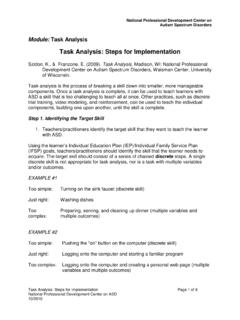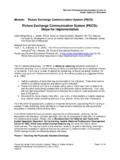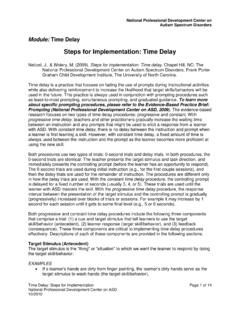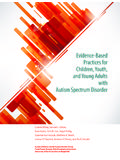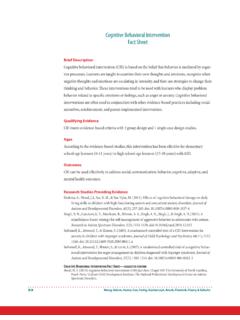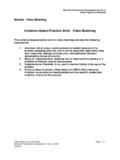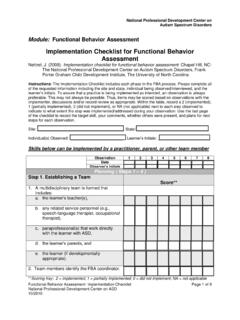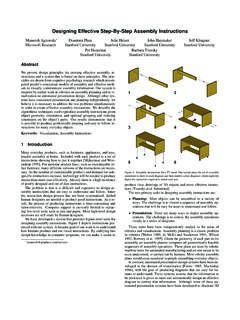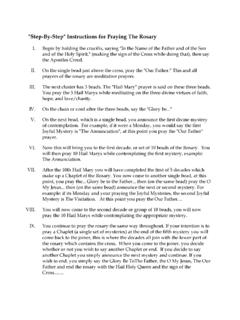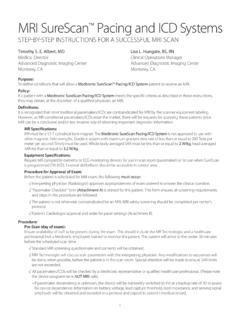Transcription of STEP-BY-STEP INSTRUCTIONS - Autism PDC
1 National Professional Development Center on Autism Spectrum Disorders MODULE: DISCRETE TRIAL TRAINING (DTT) STEP-BY-STEP INSTRUCTIONS step 1. Deciding What to Teach: Assessment and Summarizing Results 1. Team members decide which of the learner s IFSP or IEP objectives will be taught using a DTT approach. Some learning objectives are better taught using DTT than others. Objectives that involve fine and gross motor skills, recreation, self care, cognitive, and academic skills are very often appropriate for DTT. DTT is only used when a learner is not making adequate progress in other more naturalistic teaching formats. 2. Team members discuss the planned use of DTT for the particular learning objective with other team members, especially parents/family members. Team members who either have expertise in areas related to the objective or who will be teaching the skill should be consulted.
2 This discussion could occur during the IEP/IFSP planning or progress review meeting. 3. Team members examine the target IEP/IFSP objective and refine if needed. Since the DTT format relies on discrete behaviors which have a clear beginning, middle, and end; the learning objective needs to clearly state the desired antecedent, behavior, and criterion for mastery. For example, a language objective for a learner with ASD is to give two objects to an adult. To address this objective using DTT, team members would need to refine it so that the antecedent, behavior, and criterion for mastery are identified in the following ways. Antecedent: Adult says to the learner, Give me two _____. Behavior: Learner gives two objects to the adult. Criterion: Learner gives two objects to the adult during 80% of the trials.
3 This refined objective would then read: When an adult asks Michael, to give two objects (antecedent phrase), Michael will pick up the two objects and hand them to the adult (behavior phrase) in 80% of opportunities across three consecutive days (criterion). step 2. Breaking the Skill Down into Teachable Steps 1. Team members complete a task analysis of the skill, identify each step of the skill, and list steps in sequential order from entry to mastery level. National Professional Development Center on Autism Spectrum Disorders MODULE: DISCRETE TRIAL TRAINING (DTT) The cornerstone of DTT is the break down of skills into small teachable steps (Cohen, Amerine-Dickens, & Smith, 2006; Eikeseth, Smith, Jahr, & Eldevik, 2002). To complete a task analysis or lesson progression, each step of the skill is broken down and listed in sequential order.
4 For example, the steps in a lesson objective involving naming pictures in a book might look like this: Target objective for a 5 year old: When looking at a book with an adult, Steffie will answer the adult s question What s that? , accompanied by a point to a picture, by naming 10 or more different pictures of animals and vehicles in five different unfamiliar books, during 90% of opportunities across three consecutive teaching sessions. Mastery for each step is set at 90% correct independent responses during three consecutive teaching periods. 2. After completing a task analysis for each skill, team members list the steps clearly in a lesson progression so any team member can complete the trials if necessary. Lesson Progression: 1. Name 2-3 animal pictures with partial verbal prompt 2.
5 Name 2-3 animal pictures independently 3. Expressively identify 2-3 animal pictures in one familiar book 4. Expressively identify 4-5 animal pictures on cards 5. Name 4-5 animal pictures in five different books 6. Name 2-3 vehicle pictures with partial verbal prompt 7. Name 2-3 vehicle pictures independently 8. Name 2-3 vehicle pictures in one familiar book 9. Name 4-5 vehicle pictures on cards 10. Name 4-5 vehicle pictures in five different books For more information on how to complete a task analysis, please refer to the Evidence-Based Practice Brief: Task Analysis (National Professional Development Center on ASD, 2009). When listing the steps, the directions from the instructing team member (the antecedent, which is the Sd), the range of responses that are or are not acceptable, the prompting or assistance from the adult in the form of a physical, gestural, or verbal that may be required, and the consequence that the instructing team member must present to reinforce the desired behavior or to discourage an undesired behavior should be included.
6 Reviewing other evaluations/assessments may be useful to provide information about current levels of proficiency and where your teaching steps might start. Evaluations that could be referenced include: National Professional Development Center on Autism Spectrum Disorders MODULE: DISCRETE TRIAL TRAINING (DTT) speech/language, reading/literacy, and gross/fine motor. Reviewing a curriculum tool may be helpful if additional assistance is needed to decide on the steps. Curriculum assessments can be helpful as guides for refining objectives, creating a hierarchy of skills, determining a baseline level of a skill, deciding on an age appropriate demonstration of the skill, and making decisions about what skills to teach and when to teach them. Examples of curriculum-based assessment guides include: Making a Difference: Behavioral Intervention for Autism (Maurice, Green, Foxx (Eds.))
7 ,(2001) Teaching Individuals with Developmental Delays (Lovaas, 2003) A Work in Progress (Leaf & McEachin, 1999) Behavioral Intervention for Young Children with Autism (Maurice, Green, & Luce, 1996) Assessment of Basic Learning and Language Skills (Partington & Sundberg, 1998) Early Start Denver Model for Young Children with Autism : Promoting language, learning, and engagement (Rogers & Dawson, 2010) step 3. Setting-up the Data Collection System 1. Team members select data sheets specifically designed for the skill being taught. One of the defining characteristics of a high quality discrete trial training program is the collection of trial by trial data. When setting up the DTT instruction plan, it is important to have data sheets specifically designed for the skill being taught.
8 Different skills require different approaches to measurement. Sometimes it is possible to combine two different types of data sheets into one document. For example, a data sheet that is considered self graphing means that you mark the trial-by-trial data directly into graphing squares. Data sheets of this sort can be helpful because there are fewer steps to show the data in both a trial-by-trial and visual format. See sample data sheets that accompany this document. Table 1 provides a list of materials that should be considered when setting up a data collection system. Table 1. Suggested Materials to Include in the Data Collection System Trial by trial data sheets which contain: a place for documenting prompt level (Please see Prompting Brief) key for abbreviations criteria for mastery National Professional Development Center on Autism Spectrum Disorders MODULE: DISCRETE TRIAL TRAINING (DTT) places to record the dates when trials are introduced and mastered Graphing sheets Data sheets which are both trial-by-trial and graphing in one ( , self graphing) Other necessary data sheets (toileting, food intake, etc.)
9 Summary sheet for each session step 4. Designating Location(s) 1. Team members generate a list of possible locations in which the teaching can take place. Selecting an appropriate location or locations for teaching is a very important part of planning DTT instruction. When the team meets either during the IEP/IFSP meeting or separately, it might be helpful to generate a list of possible locations where the teaching can take place. Each location should be carefully examined to determine the advantages and disadvantages of that location. Considerations might include: a quiet place without too many distractions, sufficient space for instruction and for breaks, easy access to peers for generalization, and adequate lighting and seating (seat and table that fits the learner s body, with feet and back supported by the chair and hips, knees, ankles, and elbows at 90 degrees).
10 2. Team members select location(s) for DTT. Often, two or more locations are better than one, because multiple locations can be helpful when working toward generalization. step 5. Gathering Materials 1. Team members assemble materials to be used during the teaching. Having the correct materials will make your program easier and more efficient to run. Below is a list of materials that will be helpful in setting up your program: notebooks/ binders for data collection and team communication preference list or menu based on preference assessment variety of tangible reinforcers (edible and non-edible) pictures or icons of preferred social activities (reinforcers) instructional materials (letters, shapes, colors) National Professional Development Center on Autism Spectrum Disorders MODULE: DISCRETE TRIAL TRAINING (DTT) object related materials (blocks, toys, real life materials) pens, pencils, markers bins for storage which can be clearly labeled step 6.
